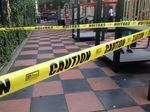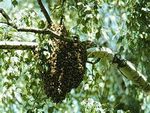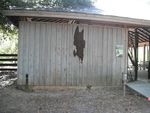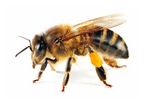Health Services Bees & Wasps Fact Sheet - Latrobe City Council
←
→
Page content transcription
If your browser does not render page correctly, please read the page content below
Health Services
Bees & Wasps Fact Sheet
WASPS
The European Wasp is easily identified by its
bright yellow legs and body and black triangular
markings on the abdomen. In comparison to
bees, wasps are larger and less hairy. European
Wasps are not usually aggressive unless
aggravated. They do, however, have the ability
to sting many times and do not die after stinging.
Finding the Nest
European Wasps often make their nests where shelter is available such as
holes in the ground, wall cavities and trees. They rarely nest out in the open. A
nest is usually detectable by a stream of wasps entering and leaving a hole.
They can be found in large communal nests, normally only visible as a small
entrance hole.
European Wasps do not hover, but fly directly
backwards and forwards to the nest. To find the
nest, you need to establish the direction the
wasps are flying in. European Wasp nests are
generally ball shaped and made from a grey
coloured material similar to paper Mache.
Once the nest has been located, do not disturb
it during daylight. If disturbed, European Wasps
will release a chemical which triggers other wasps to the nest as a defence.
Keep family and animals away from the nest.
Eradication of European Wasp Nests on Private Land
If you are able to access the wasp nest safely, you can purchase insect dust
which is available from the supermarket or hardware shops. This is a white
dust and for best results it needs to be put into the mouth of the nest at night
when the wasps are inactive. The wasps will carry this dust on their body as
they travel in and out of the nest the following day. Usually two applications
will be sufficient. It is important to read and follow the manufacturer’s
instructions/recommendations when using any pesticide.
If the insect dust has not worked, or the nest is not readily accessible, it is
advisable to contact someone in pest control. Numbers can be obtained from
the Yellow Pages.
Version 4 2020Health Services
Bees & Wasps Fact Sheet
European Wasps are attracted to meat and sweet foods, which is why they can
be a nuisance at BBQ’s and outdoor dining. They do not collect pollen from
trees and flowers but are attracted to nectar.
• Do not leave food scraps lying around
• Where possible, avoid leaving uneaten pet food or dog bones outside
• Ensure rubbish bins have lids tightly fitted
• Keep compost covered
• Cover water sources when not in use – e.g. pools
• Where possible, don’t drink out of cans or bottles outside. Use clear
containers or straws
• Cover exposed food at BBQ’s and picnics
• Cover bird baths and fish ponds with shade cloth
If you find a wasp nest on Council land, contact
Council’s Health Services Team on 1300 367 700
EUROPEAN HONEY BEES
Bees play a crucial role in pollinating plants throughout
our environment. When bees travel from flower to
flower they transport pollen to other flowers allowing
plants to develop seeds and reproduce. Bees are
necessary for our agricultural industry pollinating more
than 90 of our key flowering crops such as apples,
asparagus, avocados, blueberries, broccoli, celery,
cherries, citrus crops, cranberries, cucumber, kiwis and melons, just to name a
few.
Bees also provide us with honey and wax products that can be used for
consumption and medical products.
If we can protect or relocate bee swarms rather than having them destroyed
they will continue to work for the benefit of the community.
Version 4 2020Health Services
Bees & Wasps Fact Sheet
http://agriculture.vic.gov.au/agriculture/livestock/honey-bees
Bees are social insects that form hives. The adults
feed on pollen and nectar and larvae may be
foliage eaters or woodborers.
Swarming is part of the natural reproductive life
cycle of honeybees. When a bee colony becomes
too large it divides by swarming. Swarming is the
process by which a new honey bee colony is
formed when the queen bee leaves the colony with
a large group of worker bees.
In the prime swarm, about 60% of the worker bees leave the original hive
location with the old queen. This swarm can contain thousands to tens of
thousands of bees.
Swarming is mainly a spring phenomenon, usually within a two- or three-week
period depending on the locale, but occasional swarms can happen throughout
the producing season. Secondary after-swarms may happen but are rare.
After-swarms are usually smaller and are accompanied by one or more virgin
queens. Sometimes a beehive will swarm in succession until it is almost totally
depleted of workers.
Here in Victoria the swarming season is usually between September and
December. However, occasionally colonies may swarm at other times. Warmer
weather, combined with an abundance of nectar and pollen, stimulate the
colony to increase in population. Swarms usually emerge from the colonies
between 10am and 2pm on warm sunny days.
A swarm of honeybees will cluster temporarily at one location, often hanging
off the branch of a tree or bush, while a few scout bees locate a new home.
When a suitable home is found the swarm moves as a group to that new site.
This is usually after a few hours or up to a couple of days.
Preventative measures include disposing of all rubbish effectively; having tight
fitting lids on bins; and disposing of all food scraps appropriately.
If people keep away from these swarms they will usually leave the site in a few
hours and of their own accord; its only when the swarm rests on objects that
are likely to bring them in close contact with people (or animals) that the
swarms may need to be relocated urgently and the swarm taped off to prevent
accidental contact with the bees.
Version 4 2020Health Services
Bees & Wasps Fact Sheet
Whilst pest control companies can kill and remove the bees, there are some
beekeepers (apiarist) that are prepared to collect swarms free of charge. Refer
to the Yellow Pages for contact details. The Latrobe Valley Beekeepers
Association (LVBA) provide a free swarm collection service, as well as the
removal of established bee nests where possible.
To assist in finding a nearby swarm collector,
telephone the Council’s Coordinator Environment
on 0409 015 237
HOW COUNCIL CAN ASSIST
Council strongly encourages residents to discuss the issue with relevant
householders if they think bees and wasps are coming from their neighbour’s
property.
Should this approach prove ineffective, Dispute Settlement Centre provides a
range of free, confidential dispute resolution services. They may be able to
assist without the need for expensive legal proceedings and can be contacted
on 1800 658 528 (toll free).
Version 4 2020You can also read



























































